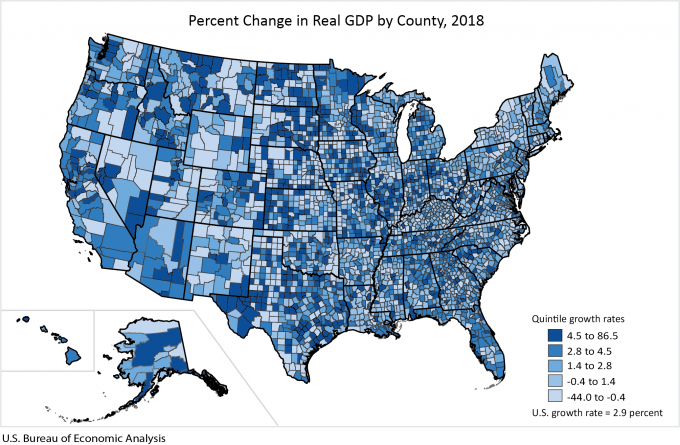by Valorie H. Rice
Senior Specialist, Business Information
Current Data Releases as of 20 December 2019
The Bureau of Economic Analysis released Local Area Gross Domestic Product on December 12 including metropolitan areas and counties. This marked the first official release of data for real GDP at the county level. To be expected, Maricopa County had the largest real GDP in the state for 2018 followed by Pima County. The percent change in GDP from 2017 to 2018 ranged from 0.3 percent in Coconino and Gila counties to 7.2 percent in Graham County.

Arizona job growth was 2.4 percent year-to-year in November, compared to 1.5 percent for the nation. Industries with the most over-the-year employment gains in the state for November were education and health services; trade, transportation, and utilities; and construction according to the December 19 Arizona Office of Economic Opportunity release. The seasonally adjusted unemployment rate lowered to 4.7 percent for the month, the lowest it has been all year.
Compare employment by sector by clicking titles on/off in legend below the chart. Your cursor becomes a tooltip.
U.S. real GDP increased at a seasonally adjusted annual rate of 2.1 percent in the third quarter as indicated by the Bureau of Economic Analysis December 20 release. The second quarter 2019 real GDP increase was 2.0 percent.
Arizona state personal income increased 3.8 percent in the third quarter 2019, the same rate as the U.S. average according to the December 18 Bureau of Economic Analysis release. Increases in state personal income ranged from 15.2 percent in South Dakota down to 1.9 percent for West Virginia and Wyoming.
The Arizona Office of Economic Opportunity released July 1, 2019 population estimates for Arizona, Arizona counties and incorporated places on December 13. According to the report, Arizona’s population now stands at 7,187,990, a 1.6 percent increase over 2018. Population growth varied among counties with Apache, Greenlee and Cochise losing population over-the-year while Pinal gained 3.3 percent.
Consumer prices increased 0.3 percent over-the-month in November, seasonally adjusted. The Bureau of Labor Statistics December 11 release indicated that shelter and energy price increases were once again a large factor in the rise of the overall index as they were last month. The index for all items less food and energy was up 0.2 percent. Annual inflation increased 2.1 percent for November.
The U.S. gained 266,000 nonfarm payroll jobs in November, the highest monthly figure since January. After upward revisions to September and October employment figures, the average job gains over the last three months was 205,000. Health care as well as professional and technical services had sizable growth over-the-month. The national unemployment rate ticked down to 3.5 percent for November according to the December 6 Bureau of Labor Statistics report.
The U.S. trade deficit continued to lessen in October, moving down to $47.2 billion from a revised September figure of $51.1 billion. Both exports and imports were down for the month. Exports decreased $0.4 billion to $207.1 billion and imports dropped $4.3 billion from September to $254.3 billion. Year-to-date, the deficit in goods and services was 1.3 percent above the same period in 2018 according to the December 5 joint Census Bureau and Bureau of Economic Analysis release.
Arizona had 1,143 bankruptcy filings in November. This was down from the same month a year ago when the figure was 1,220. Year-to-date bankruptcies are up 3.4 percent for the state with filings increasing 4.3 percent for the Phoenix office, 0.7 percent for the Tucson office, and 3.1 percent for the Yuma office. The Phoenix office includes Apache, Coconino, Gila, Maricopa, Navajo, and Yavapai counties. The Tucson office handles Cochise, Graham, Greenlee, Pima, Pinal, and Santa Cruz counties, while the Yuma office represents La Paz, Mohave, and Yuma counties.
Wishing you a happy and prosperous 2020!





